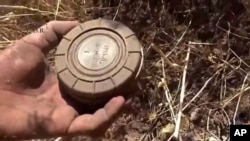An international landmine watchdog says new uses of the weapon are “extremely rare” but that fighting in Afghanistan, Libya, Ukraine and Yemen has led to a second consecutive year of high casualties.
The International Campaign to Ban Landmines said in an annual report Thursday there were 8,605 casualties, including 2,089 deaths, from mines in 2016. That includes improvised explosive devices and unexploded ordnance that are triggered like mines.
Of those casualties, 78 percent were civilians, and the total included the most child casualties ever recorded. They took place in 52 countries.
“A few intense conflicts, where utter disregard for civilian safety persists, have resulted in very high numbers of mine casualties for the second year in a row,” said Loren Persi, casualties and victim assistance editor of Landmine Monitor. “This shows the need for all countries to join the Mine Ban Treaty and for increased levels of assistance to mine victims.”
1999 international treaty
Under a 1999 international treaty, countries agree to not use or produce antipersonnel mines, to destroy their existing stockpiles, provide assistance to mine victims and clear their territory of mines within 10 years of joining the pact.
On Wednesday, the ICBL welcomed Sri Lanka as the 163rd country to be fully bound by the treaty and said it hopes others in the region will join as well.
Thursday’s report said Myanmar and Syria had the only government forces that actively planted mines during the past year. Neither is a party to the mine ban treaty.
The report cites 61 states and areas contaminated with mines as of November, and while 33 of those are a part of the treaty, only Chile, Mauritania, Peru and the Democratic Republic of Congo are on track to meet their deadline for clearing territory of mines.
Algeria and Mozambique completed their clearing operations during 2017. Worldwide, the report says a total of 170 square kilometers was cleared during 2016, and the vast majority of that work took place in Afghanistan, Croatia, Iraq and Cambodia.
Much work yet to be done
Still, large areas of mine contamination are believed to exist in a number of countries. Those include Afghanistan, Angola, Azerbaijan, Bosnia and Herzegovina, Cambodia, Chad, Croatia, Iraq, Thailand and Turkey.
International efforts linked to the treaty also extend to assisting victims, educating people about the risks of mines, destroying stockpiles and monitoring mine use. The report says monetary contributions rose sharply in 2016 to $480 million to support that work.











